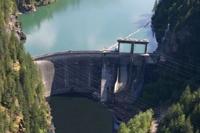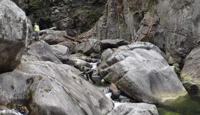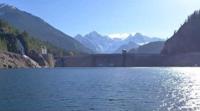The series of concrete dams strung across the upper Skagit River predate construction of the North Cascades Highway and the establishing of North Cascades National Park.
Their construction — starting in 1917 with Gorge, then Diablo and finally Ross — also predates the listing of Puget Sound chinook salmon and steelhead trout as threatened under the federal Endangered Species Act in 1999 and 2007.
Whether the dams harm those threatened fish is getting ample attention as Seattle City Light, which operates the three-dam Skagit River Hydroelectric Project, seeks a new license from the Federal Energy Regulatory Commission (FERC).
Some are calling for Seattle City Light and FERC to consider the impact of the dams on salmon and steelhead and whether fish passage projects — or even removal of Gorge Dam — should be required as part of the relicensing.
"Fish passage is a huge issue for us," Upper Skagit Indian Tribe Natural Resources Director Scott Schuyler said. "The tribe relies on salmon to support our fishing culture and it's part of our history ... but it also impacts so many things in Skagit County that are affected by the decline of the salmon and salmon restoration. It's time to do a reboot."
A multiyear dam relicensing process began in April when Seattle City Light filed a pre-application document and a list of 24 studies it proposes conducting. The utility is seeking a new, 50-year license to continue to operate the dams.

The Gorge Dam is the lowest of the three on the Skagit River, and the Upper Skagit Indian Tribe is asking its removal to be considered as part of Seattle City Light’s relicensing process for dam operations.
A FISH PASSAGE PROBLEM?
As salmon and steelhead populations have dwindled throughout the Pacific Northwest, the impact dams have on fish passage, on water quality and on natural habitat development are topics that have gained interest.
In some places, that has resulted in the removal of dams, such as on the Elwha River on the Olympic Peninsula. In others, dams have been the subject of drawn-out debate, such as along the lower Snake River in southeast Washington.
The call to look into the effects of the dams on the Skagit River is being led by the Upper Skagit tribe, and has the support of other tribes, nonprofit conservation groups, and government agencies at the county, state and federal levels.
"We don't think it's unreasonable to want to understand: What are the effects?" Schuyler said.
While the relicensing process is in its early stages, the interest in addressing fish passage is clear in comments submitted to Seattle City Light and FERC.
The National Marine Fisheries Service, the state Department of Fish & Wildlife, the Skagit County Board of Commissioners and the Swinomish Indian Tribal Community are among those asking for fish passage to be studied.
"Right now the question is 'Should a fish passage study be performed?' and basically everybody in the natural resource caucus is saying yes," Swinomish Indian Tribal Community Environmental Policy Director Amy Trainer said. "We are in support of and in agreement with other treaty tribes and with our state and federal natural resource partners."
State and federal wildlife management agencies are particularly interested in the impacts on the threatened fish species, as well as the trickle-down effect on the endangered Southern Resident orca whales that eat chinook, according to submitted comments.
Seattle City Light's Skagit License Manager Andrew Bearlin said the utility is not surprised by the requests to study the effects of improving fish passage on the threatened species.
"It is an issue that needs to be addressed for nearly all hydroelectric projects in the Pacific Northwest," he said.
However, according to Seattle City Light and FERC, removal of Gorge Dam doesn't fit within the scope of relicensing.
"Dam removal is typically not included in relicensing unless the applicant is planning to decommission the project," Bearlin said.

Seattle City Light believes this stretch of the Skagit River is naturally unpassable for fish. Tribes, wildlife management agencies and others disagree.
THE RELICENSING
The three dams that make up the Skagit River Hydroelectric Project provide about 20% of the electricity used in the city of Seattle each year.
The existing 30-year license for the dams expires April 30, 2025.
Seattle City Light's pre-application documents indicate three projects the utility wants to complete under a new license — construction of a new dock on Diablo Lake, dredging between the Gorge and Diablo dams, and building a pump system to move water between Diablo and Ross lakes.
The comment period for the pre-application document and the proposed studies closed Oct. 27. The comment period for FERC's concurrent review of the proposed license under the National Environmental Policy Act closed Oct. 24.
Documents uploaded to a FERC web page for the dam license show 27 responses were received. FERC spokesperson Celeste Miller said comments on the scope of FERC's environmental review came from 22 government, tribal and nonprofit entities.
Bearlin said the study requests are the start of the process through which FERC will determine what will be studied. Seattle City Light must respond to study requests by Dec. 8, and a public meeting will be held with FERC in early January.
"It's a work in progress; a kind of give-and-take conversation that hopefully gets us to a comprehensive set of studies that helps us understand the impacts of the project," Bearlin said.
Miller said FERC also plans to issue a scoping document by Dec. 8.
Among those who submitted scoping comments and study requests are the Army Corps of Engineers, the National Oceanic and Atmospheric Administration, the U.S. Forest Service, the National Park Service, the state Department of Fish & Wildlife, the state Department of Ecology, the Skagit County Board of Commissioners, the Skagit County Drainage and Irrigation Districts Consortium, and the Upper Skagit, Swinomish, Sauk-Suiattle and Stillaguamish tribes.
In addition to the call for studying fish passage, commenting agencies raised other concerns, from climate science to emergency response.

Ross Dam
A FOCUS ON FISH
The National Marine Fisheries Service said in its submitted comments that the continued decline of threatened chinook and steelhead populations suggests changes are needed.
"A comprehensive evaluation of potential enhancements to project operations, including fish passage at all developments, is warranted," the agency's filing states.
The agency points to the downstream Baker River dams operated by Puget Sound Energy as an example of successful fish passage improvements.
"Design and operation of upstream and downstream passage is no longer novel in concept," the comment letter states. "Passage at the Baker River Hydroelectric Project has resulted in successful passage of sockeye salmon."
Seattle City Light, though, has long contended that the rocky 2.5-mile section of riverbed between the Gorge Powerhouse and Gorge Dam is naturally unpassable for fish.
"Much of this reach is upstream of several natural barriers," Seattle City Light's pre-application document states, with reference to a study published in 1921.
Seattle City Light records dated from 1927 and 1936 indicate state fisheries officials did not believe spawning occurred in that area.
Current representatives of the National Marine Fisheries Service and the state Department of Fish & Wildlife say that may not be true.
"Numerous reports have failed to conclude that anadromous fish passage was historically precluded above Gorge, Diablo, or Ross Dams," the National Marine Fisheries Service said.
Fish & Wildlife said salmon have been observed in recent years at the base of Gorge Dam — which wouldn't be possible if a natural barrier existed.
"In consideration of the potential benefit of providing access to known habitats upstream of the (hydroelectric) project and of the recent observations of passage to the base of Gorge Dam, we are requesting the feasibility study of providing upstream and downstream fish passage," the agency's comment letter states.
Fish & Wildlife said the dams are likely preventing fish from accessing habitat in 37% of the Skagit River watershed upstream of the dams. It is possible tributaries including Stetattle Creek above Gorge Dam and Thunder Creek above Diablo Dam could be prime spawning habitat.
Schuyler of the Upper Skagit tribe said it's time Seattle City Light's "natural barrier" narrative was tested.
"They haven't been very receptive to this concept of doing these studies that we're asking for, but if you're so certain salmon never did, couldn't, wouldn't pass through this area, what's the issue with studying it? Wouldn't you want your position validated?" he said.
Swinomish Chairman Steve Edwards said his tribe, located downstream near where the mouth of the Skagit River meets Skagit Bay, wants questions about historic fish passage and current possibilities answered, too.
"Our people rely on fish ... and salmon travel through that mouth and up that river to their spawning grounds," he said. "Whether it's the mouth or the spawning grounds, we have to protect that entire river."
The reliance of salmon and steelhead on different parts of the river system during different life stages is one reason the Swinomish tribe, along with various other commenting agencies, is asking that the licensing studies examine the entire watershed. The National Marine Fisheries Service said that includes from the headwaters of the river in British Columbia to the mouth where it meets Puget Sound.

Gorge Dam powerhouse
OTHER FACTORS
Seattle City Light documents say under settlement agreements reached in 1991 during its previous relicensing, that it prioritizes flood control, fish protection, recreation and power production — in that order.
This time around, Skagit County leaders are concerned about the impacts climate change may have on the regional water supply and on flood risk.
"Flood protection is critical to the safety of residents and the long term economic viability of Skagit County," states a comment letter from representatives of Skagit County dike, drainage and irrigation districts.
The letter said ensuring water availability for the agricultural sector to irrigate as needed is important, too.
And when it comes to fish, county and tribal leaders say factors beyond passage to the upper watershed are also important to consider.
Skagit County and the Swinomish tribe, for example, question the benefits Seattle City Light's mitigation lands program — encompassing about 11,000 acres in Skagit County — provides for salmon.
They say one problem is that 40% of that land is in the Nooksack River watershed, instead of concentrated in the upper Skagit River watershed where the impacts of dam construction and reservoir inundation have taken place.
"We are concerned that there may have been a net loss in both the quantity and quality of wildlife habitat in the area of the project," a comment letter from the Swinomish tribe states.
The efforts of Seattle City Light under the existing agreements have not gone unnoticed, but neither has the loss of salmon in the Skagit River.
"We applaud those efforts that they have done, but it simply hasn't been enough to protect the Skagit and stem the decline of the salmon," the Upper Skagit Indian Tribe's Schuyler said.

Janelle Schuyler is shown at Gorge Dam. She is the daughter of Upper Skagit Indian Tribe Natural Resources Director Scott Schuyler.
November 22, 2020 at 09:00PM
https://ift.tt/35TYUz9
Fish passage studies sought in Skagit River dam relicensing - goskagit.com
https://ift.tt/35JkYuc
Fish
No comments:
Post a Comment